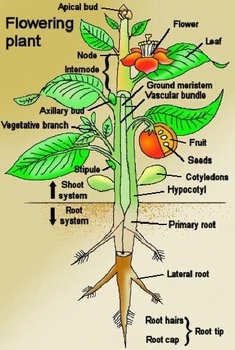Botany Notes – On – Plant Anatomy – For W.B.C.S. Examination.
Plant anatomy refers to the detailed structure of the plant: leaf, stem, roots, flowers, and fruits, while plant physiology is concerned with the processes that occur within the plant that account for it being alive and productive. A living plant must collect a few simple materials from the environment: water, oxygen, carbon dioxide, and several minerals.Continue Reading Botany Notes – On – Plant Anatomy – For W.B.C.S. Examination.
From these simple materials, the plant uses light energy to synthesize more complex substances, e.g., carbohydrates, which are in turn used to synthesize other complex substances such as proteins and lipids. Simple materials and more complex substances need to be transported within the plant to locations where they are needed. Plants utilize these materials to produce cells and organs, which leads to growth and development. There are control systems within the plant to ensure that growth and development occur in an ordered way. In this chapter, we first examine details of plant structure and architecture, and then proceed to look at the important physiological processes of photosynthesis, translocation, and transpiration.
Plant anatomy is the study of the shape, structure, and size of plants. As a part of botany (the study of plants), plant anatomy focuses on the structural or body parts and systems that make up a plant. A typical plant body consists of three major vegetative organs: the root, the stem, and the leaf, as well as a set of reproductive parts that include flowers, fruits, and seeds.
As a living thing, all of a plant’s parts are made up of cells. Although plant cells have a flexible membrane like animal cells, a plant cell also has a strong wall made of cellulose that gives it a rigid shape. Unlike animal cells, plant cells also have chloroplasts that capture the Sun’s light energy and convert it into food for itself. Like any complex living thing, a plant organizes a group of specialized cells into what are called tissues that perform a specific function. For example, plants therefore have epidermal tissue that forms a protective layer on its surface. They also have parenchyma tissue usually used to store energy. The “veins” or pipeline of a plant are made up of vascular tissue that distribute water, minerals, and nutrients throughout the plant. Combined tissues form organs that play an even more complex role.
THE ROOTS
A plant’s roots, like the foundation of a skyscraper, help it to stay upright. They also absorb water and dissolved minerals from the ground and give the plant what it needs to make its own food. Most roots grow underground and move downward because of the influence of gravity, although the roots of some water plants float. Other root systems, like that of the English ivy, actually attach themselves to a vertical surface and allow the plant to climb. There are two main types of root systems: taproot and fibrous. Plants that have taproots grow a single, long root that penetrates straight down and firmly anchors the plant. Trees and dandelions have taproots that serve this function. Fibrous roots are shorter and more shallow and form a branching network. Grass has a fibrous root system that grows at a shallow level and in all directions. Inside a root are pipelines or veins that carry water and minerals to the rest of the plant. These pipes are concentrated in the center of the root, like the lead in the center of a pencil. At the end of each root is a cap that protects it as it pushes farther into the soil. Extending from the sides of the root, but further back from the root cap are root hairs. These hairs are the main water and oxygen absorbing parts of a plant. Materials enter and leave roots by two main processes: diffusion and osmosis. When molecules are distributed unequally, nature always seeks a balance and molecules will move from an area of high concentration to one of low concentration. When the cells of a root hair have little oxygen and the soil around the root hair has a lot, oxygen will move from the soil to the root automatically without the plant having to expend any energy. Osmosis is a similar situation (from high to low concentration), but it occurs when molecules, like those of water, move across a membrane that will not allow other materials to pass. Like diffusion, osmosis does not require the plant to use any energy.
THE STEMS
Plant stems perform two functions. They support the parts of the plant aboveground (usually the buds, leaves, and flowers), and they carry water and food from place to place within the plant itself. A stem is made up of an outer layer, the epidermis; an inner layer, the cortex; and a central zone called the pith. The stem of a green plant holds itself up by having thousands of cells lined up next to and on top of each other. As the cells take in water, they expand like a full balloon, and since their walls are elastic, they stretch very tight against each other and against the stem wall. It is their pressure that holds the stem up. A plant droops when its cells lack water and have begun to shrink. Woody plants, like trees, also contain a material called lignin that strengthen cell walls and make them more rigid. A plant’s stem also functions as its circulatory system and uses what is called vascular tissue to form long tubes through which materials move from the roots to the leaves and from the leaves to the roots.
Please subscribe here to get all future updates on this post/page/category/website


 Toll Free 1800 572 9282
Toll Free 1800 572 9282  mailus@wbcsmadeeasy.in
mailus@wbcsmadeeasy.in



















































































































